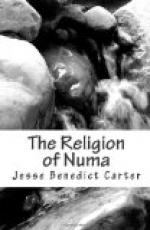But this element of superstition was already on the way, it came in within a few years of the opening of the republic, and it exercised its insidious influence ever more and more powerfully until it celebrated its wildest orgies in the time of the Second Punic War. It is in this period of the first three centuries of the republic, roughly from B.C. 500 to B.C. 200, that this change was produced. Outwardly it resembled a steady growth in religious feeling and enthusiasm, and it might well have seemed so to contemporaries. It was a period of many new gods and many new temples, but this in itself was no harm. It was the principle behind it which did the damage. It was the essential contradiction to what true Roman religion and Roman character demanded; and the last half of the republic paid the price for what the first half had done, in a decline of faith which has scarcely been exceeded in the world’s history.
It has been customary for writers on the history of Roman morals to attribute these changes to the coming of Greek influence; and of course in the main this is correct, but these writers have in general neglected to analyse this Greek influence more closely, and to distinguish the various aspects of it in different periods, and to ask and answer the question why this influence should be so particularly harmful to the Romans. It is generally spoken of as the influence of Greek literature and philosophy, but for our present period this is entirely incorrect, for we all know that Greek literature did not begin to influence Rome until the time of the Punic wars, and yet the Greek influence of which we speak here began to exert its effects two hundred and fifty years before the Punic wars. The real cause of the unnatural stimulation of religion during these three centuries is nothing more nor less than the books of the Sibylline oracles.




